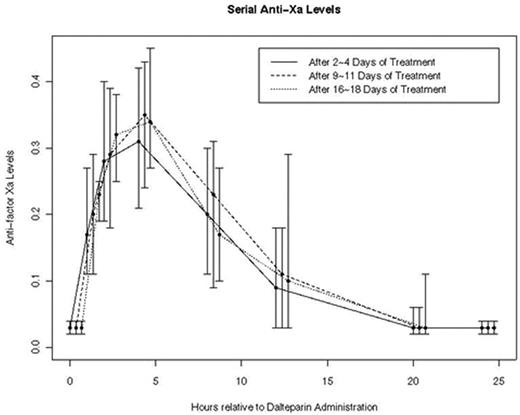Abstract
Background: Critically ill patients with renal insufficiency are at high risk for deep vein thrombosis (DVT). Low-molecular-weight heparins (LMWHs) effectively prevent DVT but are avoided in patients with renal insufficiency because of potential bioaccumulation and potential bleeding risk. However, evidence is lacking that LMWHs bioaccumulate in such patients.
Objectives: The objectives of DIRECT were, in critically ill patients with severe renal insufficiency, to determine if dalteparin prophylaxis leads to bioaccumulation and bleeding from excessive anticoagulation and to determine the pharmacodynamic profile of dalteparin.
Methods: Multi-center, open-label, prospective cohort study of critically ill patients with a creatinine clearance <30 mL/min who receive dalteparin, 5000 IU once-daily, subcutaneously for up to 30 days. Dalteparin bioaccumulation in a patient was defined by a trough anti-Xa level >0.40 IU/mL, measured twice-weekly 20 hours after the prior dalteparin dose. The pharmacodynamic profile of dalteparin was assessed by anti-Xa levels measured at 0, 1, 2, 4, 8, 12, 20, and 24 hours after the prior dose on days 3, 10, and 17 of treatment.
Results: We enrolled 156 patients with a mean (SD) creatinine clearance of 18.9 (6.5) mL/min; of these, 18 were excluded because they died or were discharged before testing (n = 3) or had prevalent DVT (n = 14) or pulmonary embolism (n = 1) within 48 hours of enrollment. Of 138 patients included, the median (inter-quartile range [IQR]) duration of dalteparin treatment was 7 days (4, 12). In 120 pa tients who had ≥1 trough anti-Xa measured (427 total), none had dalteparin bioaccumulation; the median (IQR) trough anti-Xa level was <0.1 IU/mL (<0.1, <0.1). In 138 patients who received ≥1 dose of dalteparin,10 patients (7.2%; 95% CI: 4.0, 12.8) had a major bleed, all with trough anti-Xa levels ≤0.18 IU/mL. The pharmacodynamic profile of dalteparin, shown in the Figure, was typical for drugs that do not bioaccumulate, with a typical peak and decline after 3, 10, and 17 days of treatment.
Conclusions: In critically ill patients with severe renal insufficiency, thromboprophylaxis with dalteparin did not bioaccumulate. Dalteparin, 5000 IU once-daily, appears to be a reasonable option for thromboprophylaxis of critically ill patients with severe renal insufficiency.
Author notes
Disclosure: No relevant conflicts of interest to declare.


This feature is available to Subscribers Only
Sign In or Create an Account Close Modal